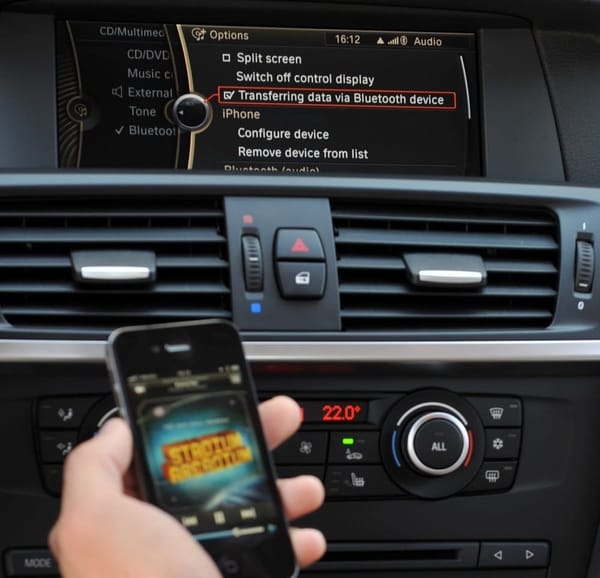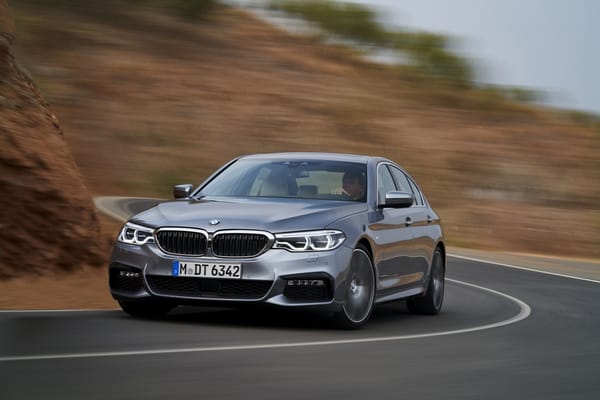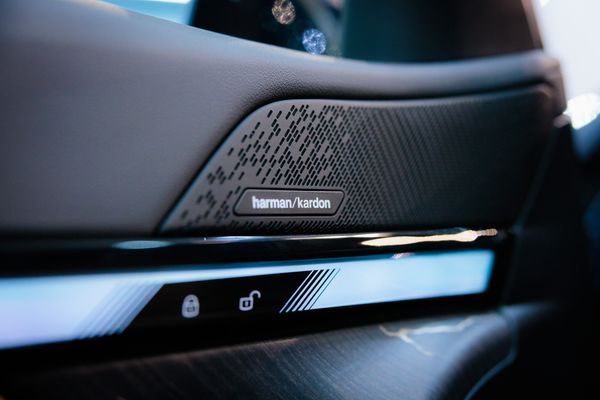Your Ultimate BMW Maintenance Schedule Guide [Updated]
![Your Ultimate BMW Maintenance Schedule Guide [Updated]](/content/images/size/w1200/2023/11/bmw-maintenance.PNG)
Alright, gearheads, if you've ever cozied up to the purr of a BMW engine or felt the tingle of excitement from a flick of its perfectly-weighted steering, you know that Bavarian Motor Works isn't just about cars – it's about an experience. But wait!
Before you get lost in those sweet memories of Bimmer rides down the Autobahn, there's the not-so-small matter of keeping your precision machine in, well, precise condition. Since 1982, BMW has taken a rather avant-garde approach to maintenance – forget those scribbled-on calendars and sticker reminders on your windshield. The car itself tells you when it needs a little TLC.
So, let's jump into the world of BMW's Integrated Service System. It's a world where sensors, algorithms, and a touch of German magic come together, all to ensure that your Ultimate Driving Machine remains, well, ultimate. Buckle up, folks; this is going to be a techy ride!
Historical Overview of BMW Integrated Maintenance System
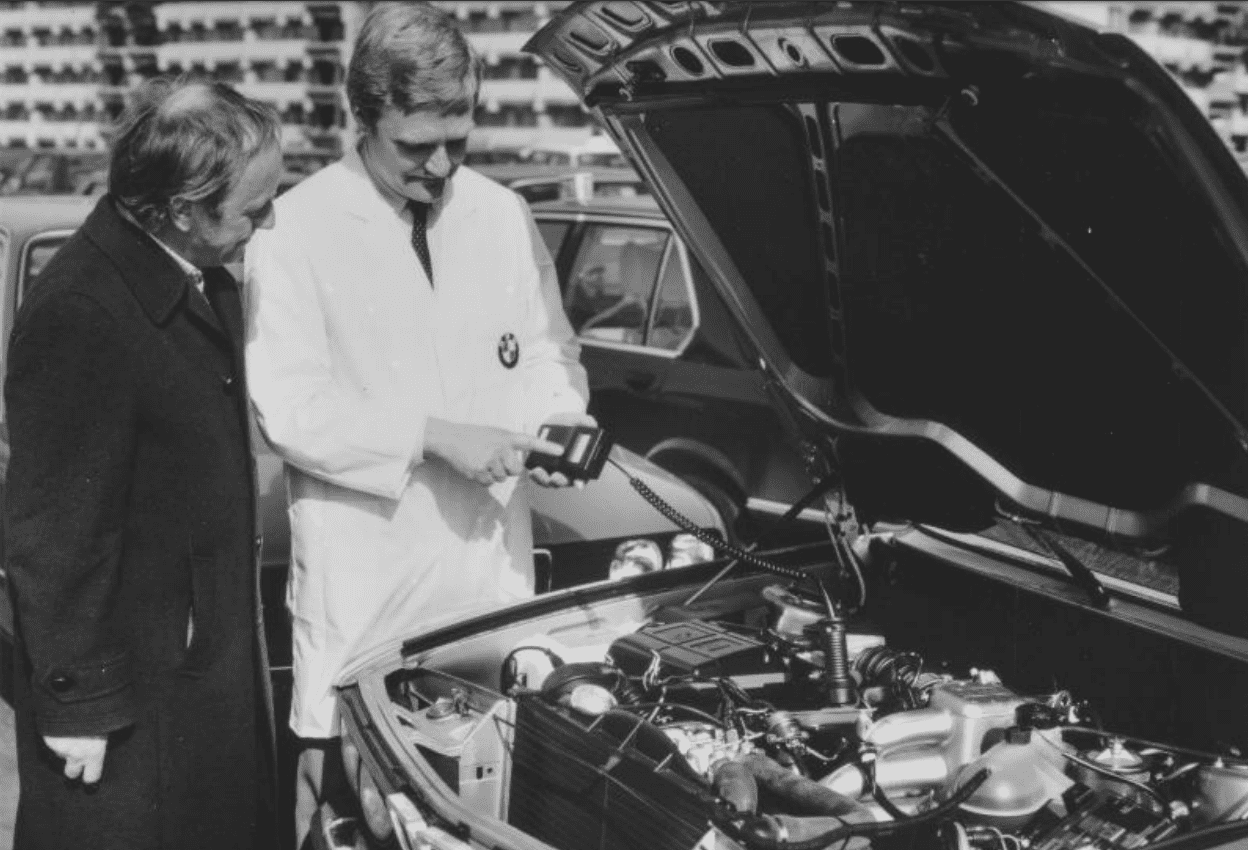
While most of us were jamming out to synth-pop, BMW was busy making automotive history. In 1982, they introduced a model that would set the pace for decades to come. No, it wasn’t just about the sleek lines or the German engineering prowess; it was the debut of an electronic wizardry system that would revolutionize car maintenance.
Enter the BMW's Service Interval Display, or Service-Intervall-Anzeige (SIA) electronic system – an alert system that was like a personal assistant for your car. Gone were the days of guesswork and manual checks. Instead, this system would tap you on the shoulder (figuratively, of course) and let you know when your prized Bimmer needed a check-up.
This electronic system wasn’t just a novelty; it was a statement. A statement that said BMW cares as much about the longevity and health of the car as the driver does. Little did we know, this was just the beginning. The 1982 electronic alert system was the precursor to the sophisticated, data-driven maintenance systems we see in today's models.
But hey, all legends have to start somewhere, right?
Understanding Service Interval Indicators (SIAs)
Alright, rev-heads, it's time to deep dive into the Service Interval Indicators, or as they're affectionately known, SIAs. Now, if SIAs were a rock band, they'd have a few albums under their belt, each with its own flavor, but all undeniably epic.
SIA I

Strap in, folks—let's rewind the clock to the '80s when BMW was busy inventing the future of car maintenance. Enter the Service Interval Indicator (SIA), the automotive equivalent of a mixtape debut—a chart-topper in its own right, starting with the '82 5 Series E28. This wasn't just a system; it was a revolution on the dashboard.
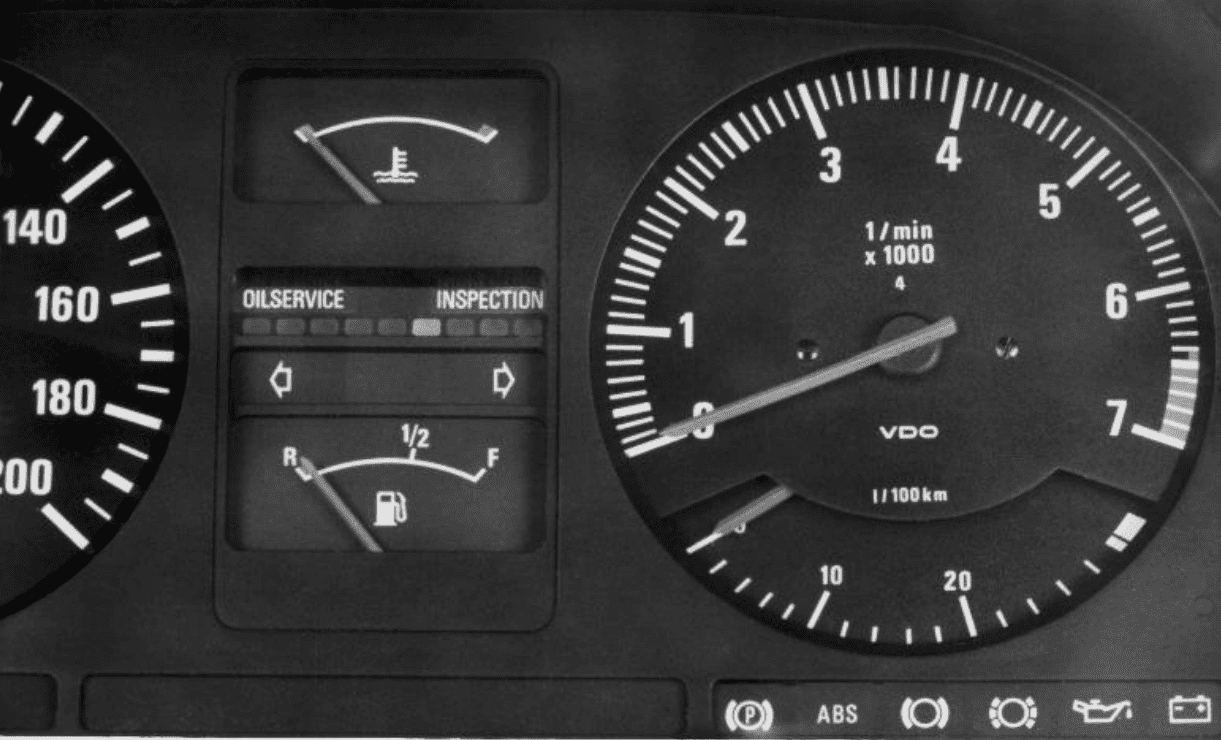
SIA I, the original hit single, brought us those LED stripes that played the role of automotive fortune tellers. Green lights meant your Bimmer was ready to rock 'n' roll, while red was more like a stage manager telling you it’s time for an intermission.
The genius behind SIA I was as straightforward as the bass line in a Springsteen anthem. Two versions were on offer: the entry-level model, counting miles and days like a tour schedule, and the headliner, adding fuel consumption into the setlist. This wasn’t just a speedo and odo jamming together—it was a full-on electronic ensemble with a Kraftstoffverbrauchsanzeige (that’s fuel consumption display for the non-German speakers), making your car's maintenance needs as intuitive as your next gear change.
SIA I knew that a Sunday driver isn't the same as a lead-footed Autobahn enthusiast—the more gas you guzzled, the sooner you'd be back for an encore service. This insight was like having your own tech crew backstage, but only if your ride was rocking Digital Motor Electronics (DME).
The first edition of SIA I had a trio of red LEDs, giving you a visual buffer even if you’d blown past your service date like a hair metal band on a reunion tour. The moment the yellow came on, you knew it was time for a tune-up. If you hit red, you were overdue but still had time before the final curtain call.
But when the E30 dropped, BMW decided to remix the SIA I, cutting it down to a solo red LED act. Each green light represented a 20% chunk of your fuel tank’s greatest hits, with a variable setlist depending on your engine’s repertoire. For the analog crowd with carburetors and L-Jetronics, it was a straight-up 1,500-mile road trip between each green LED's curtain call mixed with a total of 12 months.
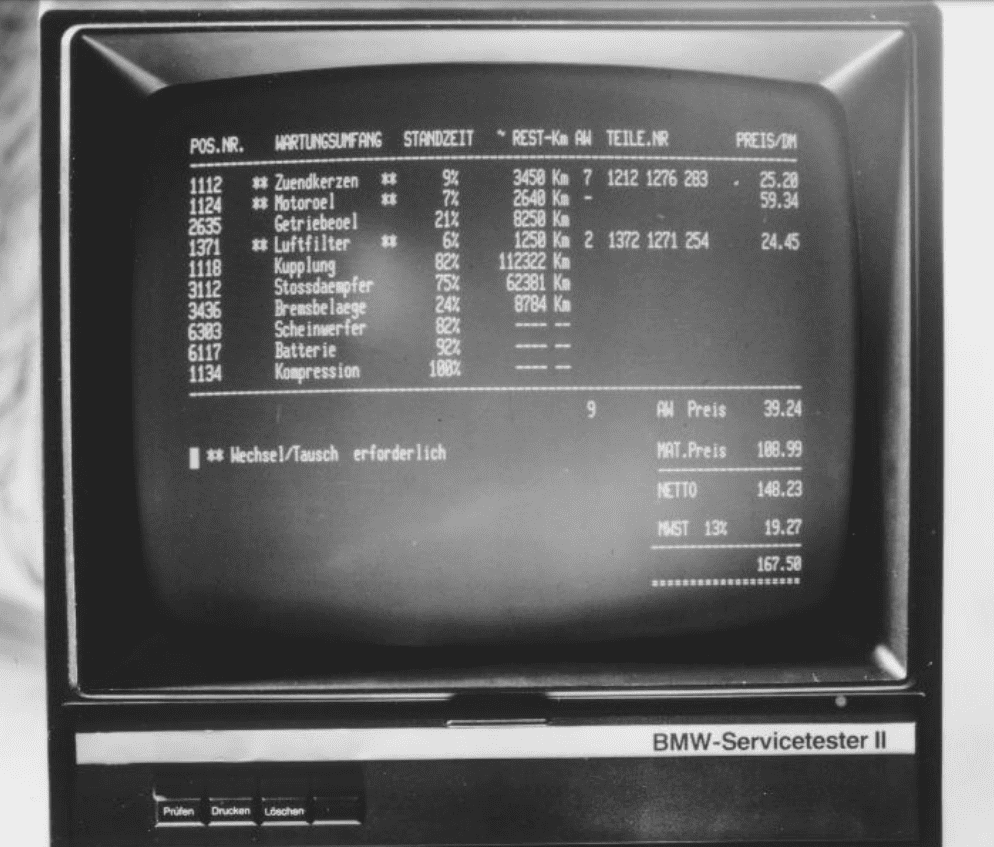
Backstage, the tech wizards had their secret weapon: the BMW Servicetester. This was the crystal ball that let the service maestros see the future of your car's performance, making modern-day diagnostics scanners seem like they're still playing in garage bands.
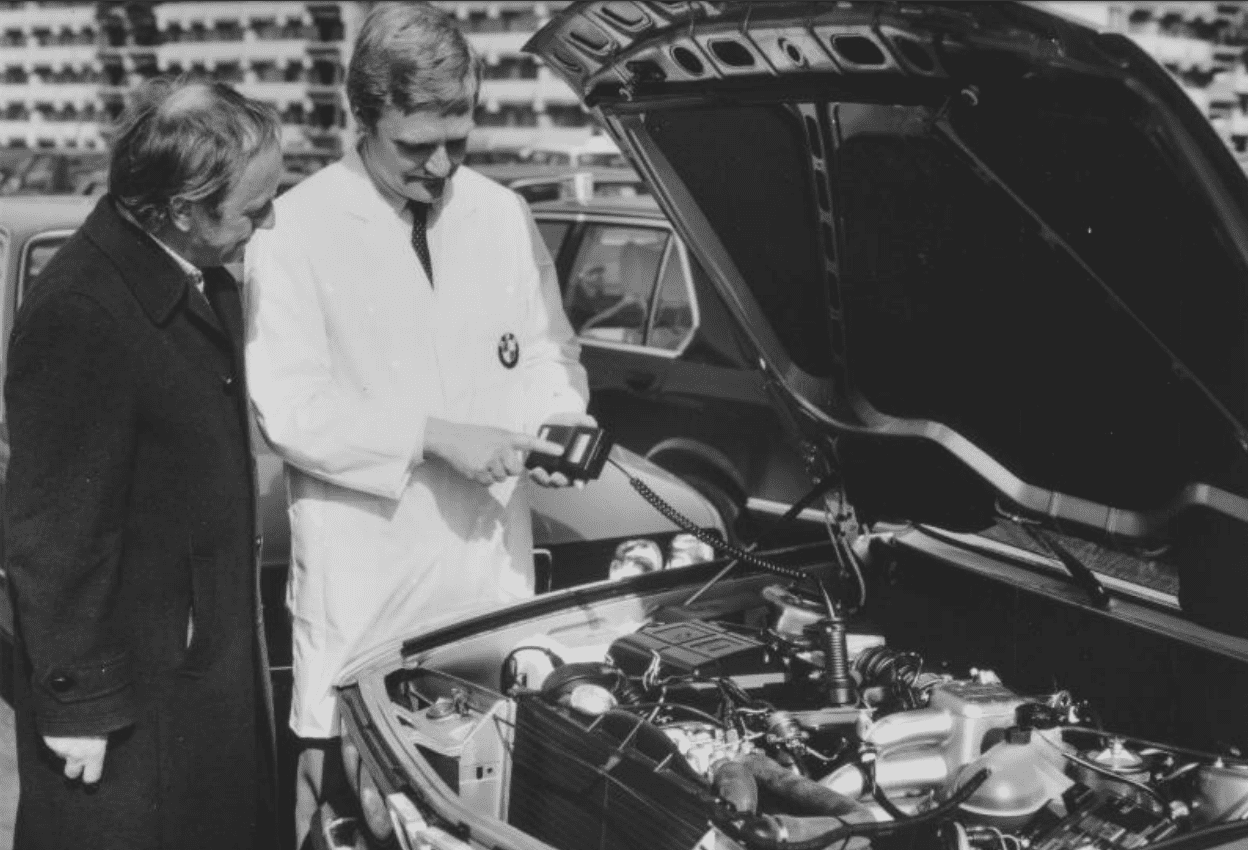
Fast forward through the decades, and BMW is still the headliner in service tech. The backstage pass has gone digital—you don't even need to show up to the gig to know the status of your ride; your key fob or smartphone gets you a VIP look.
The ethos hasn't changed: BMW's about giving you and the techs the slickest tools to keep your car in headline condition. In the grand concert of carmakers, BMW’s early dive into diagnostic tech still has them headlining festivals while others are still printing demo tapes.
SIA II

The sophomore album, hitting the scene between 1986 to 1996 (with an exception for the E36 3 Series stretching to 1999). This wasn't just a rehash of the debut. SIA II was more refined, more nuanced. It wasn't merely about the miles driven or the time passed; it took into account the nitty-gritty of driving conditions, from coolant temperatures to engine starts.
And the star of the show? Fuel consumption. With the help of the Digital Motor Electronics (DME), this system was way ahead of its time, ensuring the best maintenance intervals tailored to each driver.
SIA III
Fast forward to 1996, and cue the third album. Used in models like the E38, E39, and E53, SIA III continued the legacy but with a twist. While it retained the iconic green, yellow, and red LEDs, this system shifted its focus solely on fuel consumption.
Forget mileage, SIA III was all about the fuel. Each LED represented a percentage of fuel consumption, making maintenance recommendations even more accurate.

Each green LED (1-5) in the SIA memory corresponds to 20% of the overall fuel consumption value that was estimated (varying depending on the engine and model).
The yellow LED (6) stands for 100% and the red LED (7) for 108% of the total fuel consumption stored amount, respectively.
SIA IV
The 1998 E46 3 Series introduced us to the modern era of SIAs. Gone were the traffic light LEDs.
Instead, SIA IV embraced a digital countdown system, giving drivers a clear heads-up on the next service.
It's like the car was saying, "Hey, just a heads up, I'll need some love in X miles."
The underlying calculation was reminiscent of SIA III but with more finesse.
In essence, SIAs evolved with time, adapting to the changing needs of drivers and the advancements in technology. Each version brought something new to the table, ensuring that BMW owners always had the most accurate information about their car's health.
Dive into the Condition Based Service (CBS)
Now, imagine the music world transitioning from classic rock to electronic dance music. That's the leap BMW took when they introduced the Condition Based Service (CBS).
This wasn't just another album in the SIA series; it was a whole new genre.
Introduction to CBS
Emerging from the shadows of the SIA system, CBS was the next big thing. Think of it as the Spotify of car maintenance – personalized, intuitive, and always evolving. Introduced in 2002 with the E65 7 Series, CBS became the new standard, featured in a slew of models like the 1’ Series E87 and the 3’ Series E90/91, just to name a few.
CBS Maintenance Calculations
The CBS magic lies in its ability to adapt and predict. Let's break it down:
Engine Oil Change Forecast: CBS, staying true to its roots, heavily relies on fuel usage to determine when it's time for an oil change. Drive hard and guzzle more fuel? Your oil change intervals might be shorter. But, there's a debate about the nominal intervals. Some say they're too long, risking engine health. Others argue it's spot-on, citing BMWs that have clocked over 200,000 miles without a hiccup. The real challenge? Perfecting the algorithm to cater to different driving styles.
Microfilter Replacement Forecast: Here, CBS went full tech-nerd. Using data like rain sensor readings and heater usage, CBS tried to predict the perfect time for a cabin air filter change. Was it overly complex? Absolutely. But, in later versions, this was streamlined for efficiency.
Diesel Particulate Filter Calculation: On paper, predicting the life of a diesel particle filter sounded genius. But in practice? It's like trying to predict next year's top music hit. Too many variables. Recognizing this, BMW decided to omit the DPF prediction from the CBS display.
Brake Pad Wear Calculation: CBS tried to be the Sherlock Holmes of brake pad wear, analyzing data from brake pedal pressure to brake fluid temperature. But sometimes, even Sherlock misses the mark. Realizing the calculations were often astray, BMW pivoted to rely solely on brake pad wear sensors by 2016.
Tire Wear Prediction: The ambitious G20 3 Series endeavor. By trying to predict tire wear, BMW ventured where few had tread before. Using QR codes on tires and the tire pressure monitoring sensor, CBS aimed to give drivers a heads-up on tire replacements. Innovative? Yes. Perfect? We'll let you decide.
Utilizing the BMW KeyReader, ISPI Next, and Remote KeyRead
Alright, folks, let's park the CBS train for a moment and switch gears to some real James Bond-level tech: The BMW KeyReader, ISPI Next, and the futuristic Remote KeyRead.
Imagine walking into a BMW service center, handing over your key, and watching as they extract a treasure trove of data, all with a gadget straight out of a sci-fi flick.
The Magic of the KeyReader
Gone are the days of long-winded explanations about that strange noise you heard last Tuesday.
With the KeyReader, your BMW's key fob is more than just a tool to start your car – it's a data vault.
When you hand over your key to the service advisor, the KeyReader scans and retrieves all the Condition Based Service (CBS) data.

From oil changes to brake pad wear, it's all there. The future really is now. Actually, it has been since the "Diamond" key fob was introduced in 2000.
In the snapshot provided by the KeyReader, you might see alerts like an upcoming service due in 900 miles or by a specific date. This instant readout can highlight requirements such as:
- Engine oil service
- Fuel filter service
- Air filter service
- Microfilter service (cabin air filter) ... and much more.
ISPI Next in Action
Now, if the KeyReader is the lead singer, ISPI Next is the band's manager – ensuring everything runs smoothly behind the scenes.
This system provides a more in-depth analysis, offering detailed readouts from various BMW models, even those with older systems like the 2001 BMW X5 E53.

With ISPI Next, service advisors can get a bird's-eye view of the vehicle's entire service history and upcoming requirements.
It's like having a detailed biography of your car's life, with every service interval, part replacement, and minor tweak documented for posterity.
Remote KeyRead – The Future of Maintenance
Now, imagine not even having to visit the service center for them to understand your car's needs.
That's the magic of Remote KeyRead.
Leveraging vehicle Telematics, akin to the ConnectedDrive and Emergency Call function, Remote KeyRead allows the BMW Service center to access your car's key data remotely. All your BMW needs is to have this feature enabled.
This means, before you even think about a service appointment, the service center can proactively check service requirements, ensuring they're prepared to address your car's needs the moment you drive in.
Talk about seamless service!
In the grand orchestra of BMW's maintenance systems, the KeyReader, ISPI Next, and Remote KeyRead play pivotal roles. They ensure that the dance between car and mechanic is harmonious, with each knowing precisely what the other needs.
It's yet another testament to BMW's relentless pursuit of perfection and their commitment to delivering unparalleled service.
How to Interact with and Understand Your BMW's Service Requirements
Amidst all the tech-talk and German engineering prowess, there's one crucial piece of the puzzle: you, the driver.
How do you interact with these advanced systems and make sense of all the data they provide?
Let's demystify the process.
Instrument Cluster Insights
Each time you ignite the engine's symphony or merely turn on the ignition, your BMW's instrument cluster briefly displays the driving distance or time left until your next scheduled maintenance.
It's the car's subtle way of saying, "Hey, here's a heads-up!"
iDrive System – Your Digital Co-pilot

The iDrive system is like the brain of your BMW, and interacting with it can provide a wealth of information about service requirements.
Here's how to navigate:
- Head over to 'My Vehicle.'
- Dive into 'Vehicle status.'
- Click on 'Service required.'
- Select an entry to reveal detailed information.

Through this path, you'll unveil specifics about each service requirement, ensuring you're always in the know.
Instrument Cluster Path

For those without the central info display or just prefer a more hands-on approach:

- Use button 1 on the turn indicator lever, pressing it up or down until "SERVICE-INFO" graces the screen.
- Give button 2 (BC) a gentle press.
- Again, employ button 1 to scroll through individual service items, unveiling your BMW's innermost secrets (or at least its maintenance needs).

Remote Checks with MyBMW App
In today's digital age, your smartphone is an extension of yourself. BMW recognizes this and, with the MyBMW app, offers you insights on-the-go.
From tire wear predictions to service requirements, it's all just a tap away.
Whether you're tech-savvy or prefer the old-school approach, there's a way for every BMW owner to stay informed and ensure their vehicle remains the ultimate driving machine.
Future of Maintenance with BMW Proactive Care
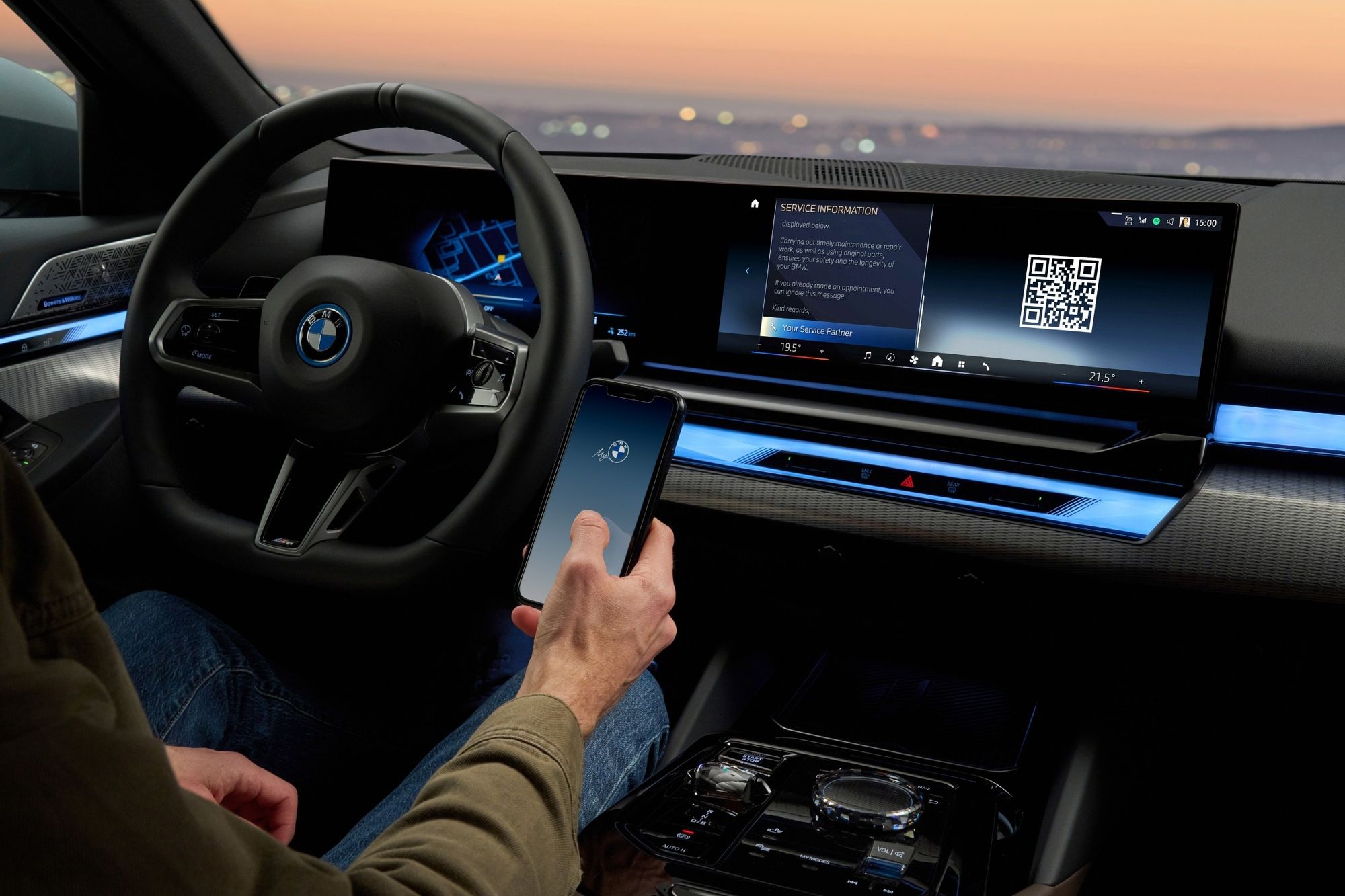
The Next Chapter in BMW's Service Evolution
As BMW continues to redefine the landscape of automotive excellence, it introduces an innovative leap in customer service—Proactive Care. This is the latest feature that takes the BMW’s already advanced maintenance systems to unprecedented levels. With Proactive Care, BMW isn't just responding to your car's needs; it's anticipating them.
Proactive Care: Your Personal BMW Concierge
Proactive Care harnesses the power of data analysis and artificial intelligence to create a digital concierge that elevates the BMW service experience. This system is not passive; it actively monitors, predicts, and addresses the service needs of your BMW.
How Proactive Care Enhances Your BMW Experience
With Proactive Care, BMW vehicles are now capable of identifying both current and forthcoming service requirements. This isn’t just about predicting when your next oil change is due; it's a comprehensive suite of services that ensures your BMW is always at its peak performance:
- Digital Tire Diagnosis: Before your tires tell a tale of wear, Proactive Care will have already analyzed their condition, offering solutions and suggestions for maintenance or replacement.
- In-Vehicle Notifications: Service alerts and maintenance reminders are no longer confined to a schedule. Your BMW will inform you through intelligent in-car notifications, ensuring you're always aware of its condition.
- Direct Dealer Communication: Gone are the days when you needed to reach out to your BMW service partner. Now, they will proactively contact you, offering a seamless service experience.
- Custom Solution Proposals: Leveraging customer data and preferences, Proactive Care delivers tailored service proposals directly to you, ensuring a personalized touch to your maintenance needs.
- Multi-Channel Customer Engagement: Whether it's through the My BMW app, an email, a call from your dealer, or even Roadside Assistance, Proactive Care communicates through your preferred channel.
- Advanced Service Scheduling and Payments: With online scheduling and service videos, including transparent online payment handling, Proactive Care simplifies the process, saving you time and effort.
The Seamless Integration of Proactive Care
To engage with Proactive Care, BMW owners need only a vehicle equipped with BMW Operating System 7 or later, an active BMW ConnectedDrive contract, and a registered vehicle in the My BMW app. The rest is taken care of by your BMW's intelligent systems:
- Data Collection Consent: A commitment to data protection and privacy is paramount. Proactive Care functions on the basis of explicit customer consent for data collection and usage.
- Personalized Service Information: The scope and cost of services are communicated transparently, allowing you to stay informed about what your BMW needs and when.
- Transparent Customer-Centric Service: Proactive Care embodies BMW's dedication to customer satisfaction, providing a transparent and intelligent service that keeps the owner's convenience at its core.
BMW Proactive Care is not just an upgrade; it's a revolution in vehicle maintenance. By integrating this service into your BMW's maintenance schedule, you not only maintain the health and longevity of your vehicle but also enjoy an unmatched level of convenience and personalized service. This is the future of automotive care—intuitive, proactive, and designed with the ultimate BMW driving experience in mind. With Proactive Care, BMW reaffirms its commitment to innovation, customer satisfaction, and the pursuit of perfection in every aspect of the driving experience.
Conclusion: The Evolution of Excellence
From the time-honored traditions of the SIA systems to the modern marvels of CBS, Remote KeyRead, and user-centric interfaces, BMW's journey in vehicle maintenance is nothing short of a masterclass in innovation.
It's not just about wrenches and oil anymore; it's about algorithms, sensors, and a relentless pursuit of perfection.
BMW has transformed the car maintenance landscape, turning routine service checks into a symphony of tech and engineering. But at the heart of it all lies a simple promise: to deliver an unparalleled driving experience to every BMW owner.
For those behind the wheel, these advancements translate to peace of mind, knowing that their vehicle is always performing at its peak and that any upcoming needs are communicated proactively. Whether you're a tech enthusiast diving deep into the digital interfaces or a purist who appreciates the brand's legacy, BMW ensures you're always in the loop.
In the grand tapestry of automotive history, BMW's commitment to intertwining cutting-edge technology with user-centric design stands out.
As we've seen with the Integrated Maintenance Schedule system, the Condition Based Service system, and the myriad of tools available to drivers, BMW isn't just building cars; they're crafting experiences.

So, the next time your BMW whispers about an upcoming service or your key fob reveals a world of information, take a moment to appreciate the journey — a journey of evolution, excellence, and an undying passion for driving.


